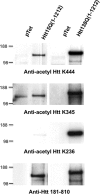Mass spectrometric identification of novel lysine acetylation sites in huntingtin
- PMID: 21685499
- PMCID: PMC3205870
- DOI: 10.1074/mcp.M111.009829
Mass spectrometric identification of novel lysine acetylation sites in huntingtin
Abstract
Huntingtin (Htt) is a protein with a polyglutamine stretch in the N-terminus and expansion of the polyglutamine stretch causes Huntington's disease (HD). Htt is a multiple domain protein whose function has not been well characterized. Previous reports have shown, however, that post-translational modifications of Htt such as phosphorylation and acetylation modulate mutant Htt toxicity, localization, and vesicular trafficking. Lysine acetylation of Htt is of particular importance in HD as this modification regulates disease progression and toxicity. Treatment of mouse models with histone deacetylase inhibitors ameliorates HD-like symptoms and alterations in acetylation of Htt promotes clearance of the protein. Given the importance of acetylation in HD and other diseases, we focused on the systematic identification of lysine acetylation sites in Htt23Q (1-612) in a cell culture model using mass spectrometry. Myc-tagged Htt23Q (1-612) overexpressed in the HEK 293T cell line was immunoprecipitated, separated by SDS-PAGE, digested and subjected to high performance liquid chromatography tandem MS analysis. Five lysine acetylation sites were identified, including three novel sites Lys-178, Lys-236, Lys-345 and two previously described sites Lys-9 and Lys-444. Antibodies specific to three of the Htt acetylation sites were produced and confirmed the acetylation sites in Htt. A multiple reaction monitoring MS assay was developed to compare quantitatively the Lys-178 acetylation level between wild-type Htt23Q and mutant Htt148Q (1-612). This report represents the first comprehensive mapping of lysine acetylation sites in N-terminal region of Htt.
Figures






Similar articles
-
Huntingtin phosphorylation sites mapped by mass spectrometry. Modulation of cleavage and toxicity.J Biol Chem. 2006 Aug 18;281(33):23686-97. doi: 10.1074/jbc.M513507200. Epub 2006 Jun 16. J Biol Chem. 2006. PMID: 16782707
-
Phosphorylation of threonine 3: implications for Huntingtin aggregation and neurotoxicity.J Biol Chem. 2009 Oct 23;284(43):29427-36. doi: 10.1074/jbc.M109.013193. Epub 2009 Aug 26. J Biol Chem. 2009. PMID: 19710014 Free PMC article.
-
A series of N-terminal epitope tagged Hdh knock-in alleles expressing normal and mutant huntingtin: their application to understanding the effect of increasing the length of normal Huntingtin's polyglutamine stretch on CAG140 mouse model pathogenesis.Mol Brain. 2012 Aug 14;5:28. doi: 10.1186/1756-6606-5-28. Mol Brain. 2012. PMID: 22892315 Free PMC article.
-
The emerging role of the first 17 amino acids of huntingtin in Huntington's disease.Biomol Concepts. 2015 Mar;6(1):33-46. doi: 10.1515/bmc-2015-0001. Biomol Concepts. 2015. PMID: 25741791 Free PMC article. Review.
-
Small changes, big impact: posttranslational modifications and function of huntingtin in Huntington disease.Neuroscientist. 2011 Oct;17(5):475-92. doi: 10.1177/1073858410390378. Epub 2011 Feb 10. Neuroscientist. 2011. PMID: 21311053 Free PMC article. Review.
Cited by
-
The N17 domain of huntingtin as a multifaceted player in Huntington's disease.Front Mol Biosci. 2025 Jan 7;11:1527313. doi: 10.3389/fmolb.2024.1527313. eCollection 2024. Front Mol Biosci. 2025. PMID: 39845903 Free PMC article. Review.
-
Integration-independent Transgenic Huntington Disease Fragment Mouse Models Reveal Distinct Phenotypes and Life Span in Vivo.J Biol Chem. 2015 Jul 31;290(31):19287-306. doi: 10.1074/jbc.M114.623561. Epub 2015 May 29. J Biol Chem. 2015. PMID: 26025364 Free PMC article.
-
Acetylation of Aβ40 Alters Aggregation in the Presence and Absence of Lipid Membranes.ACS Chem Neurosci. 2020 Jan 15;11(2):146-161. doi: 10.1021/acschemneuro.9b00483. Epub 2019 Dec 27. ACS Chem Neurosci. 2020. PMID: 31834770 Free PMC article.
-
Protein post-translational modifications: In silico prediction tools and molecular modeling.Comput Struct Biotechnol J. 2017 Mar 31;15:307-319. doi: 10.1016/j.csbj.2017.03.004. eCollection 2017. Comput Struct Biotechnol J. 2017. PMID: 28458782 Free PMC article. Review.
-
Acetylation within the First 17 Residues of Huntingtin Exon 1 Alters Aggregation and Lipid Binding.Biophys J. 2016 Jul 26;111(2):349-362. doi: 10.1016/j.bpj.2016.06.018. Biophys J. 2016. PMID: 27463137 Free PMC article.
References
-
- The Huntington's Disease Research Group, H. D. C. R. (1993) A novel gene containing a trinucleotide repeat that is expanded and unstable on Huntington's disease chromosomes. Cell 72, 971–983 - PubMed
-
- Vonsattel J. P., Myers R. H., Stevens T. J., Ferrante R. J., Bird E. D., Richardson E. P., Jr. (1985) Neuropathological classification of Huntington's disease. J. Neuropathol. Exp. Neurol. 44, 559–577 - PubMed
-
- Zuccato C., Belyaev N., Conforti P., Ooi L., Tartari M., Papadimou E., MacDonald M., Fossale E., Zeitlin S., Buckley N., Cattaneo E. (2007) Widespread disruption of repressor element-1 silencing transcription factor/neuron-restrictive silencer factor occupancy at its target genes in Huntington's disease. J. Neurosci. 27, 6972–6983 - PMC - PubMed
-
- Gafni J., Hermel E., Young J. E., Wellington C. L., Hayden M. R., Ellerby L. M. (2004) Inhibition of calpain cleavage of huntingtin reduces toxicity: accumulation of calpain/caspase fragments in the nucleus. J. Biol. Chem. 279, 20211–20220 - PubMed
-
- Cha J. H. (2000) Transcriptional dysregulation in Huntington's disease. Trends Neurosci. 23, 387–392 - PubMed
Publication types
MeSH terms
Substances
Grants and funding
LinkOut - more resources
Full Text Sources
Medical
Molecular Biology Databases
Miscellaneous

